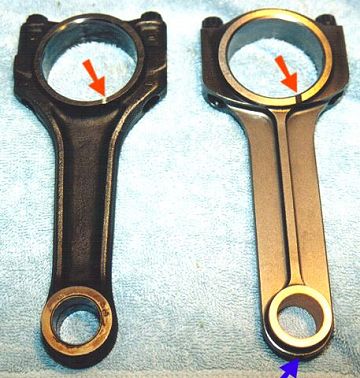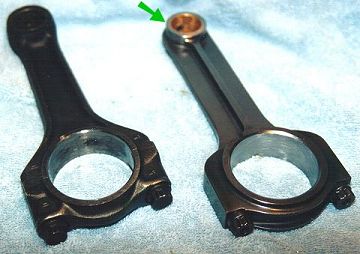
|
|
These two pictures highlight the differences between a Pauter rod and an original BMW S14 rod. It is obvious that the two designs are quite different. The BMW rods are most likely cast, although they might be partially forged. The Pauter rods are machined from forged billet. The billet 4340 chrome-moly is forged in order to re-orient the grains in the metal in the area of the big end. Then the final shape is achieved using CNC machining. The BMW rod is of the familiar "I-beam" shape, while the Pauter rods use an unusual "+" shape. Many of the high end rods in the U.S. market use an "H-beam" shape (Carillo for example). Ultimately though, the shape of the cross-section is probably not as critical as the materials used in production, and the attention paid to quality and maintaining exact dimensions. In this regard the Pauters are excellent. I was not able to measure any variation in length between the four Pauter rods, for example. And when I measured the big end inside diameters they all came out identical. The Pauters are said to come balanced right out of the box. But I brought them to my machine shop to have the balance checked anyway. And they did indeed come out identical from rod-to-rod, both in terms of total mass and big-end mass. The orange arrows in the top picture highlight the small notch which is part of the BMW rods and is duplicated in the Pauter rods per my request. This notch is there to allow engine oil from the rod bearings to splash up onto the wrist pin and cylinder walls. This is the only way that the wrist pin receives any lubrication. The Evo III block employed under-piston oil "squirters" to supply oil to the wrist pins, as well as to cool the pistons. These squirters are simple to implement on a standard block with a little machining but are dreadfully expensive (like $400 each!). I toyed briefly with adding VW oil squirters since many of their engines use them and they are very affordable (app. $25 each). But the implementation is different enough where they tap into the main galley that it would have taken a lot of work. In the end I deemed it not in my best interest. |

The blue arrow in the top photo as well as the green arrow in this photo show the small oiling hole which allows oil to drip onto the wrist pin after it has been splashed up from the rod bearing. There are also holes in the JE pistons which allow oil scraped off of the cylinder wall by the oil control ring to be fed to the part of the wrist pin inside the pistons. Remember that the wrist pin does not undergo complete revolutions, it only angles back and forth. Thus lubrication is not as critical as for the main and rod bearings and this "splash and drip" oiling method works fine. Pauter offers the option to "rifle drill" the rods so that the wrist pin is fed pressurized oil directly from the rod bearing. I opted not to go this route and just followed the standard BMW solution. I figure the rod bearings need all the oil they can get. |
|
Measuring rod bearing clearance » |
|
|